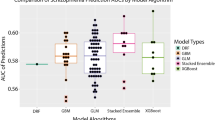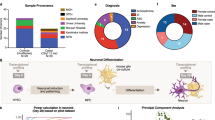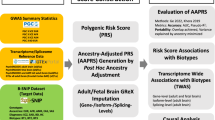Abstract
It is suggested that chromosome 18p11 is a susceptibility region for both bipolar disorder and schizophrenia. Aiming to identify susceptibility gene(s), we investigated a family whose members have either schizophrenia or schizophrenia-spectrum psychosis and carried a t(18;21)(p11.1;p11.1) translocation. Fluorescence in situ hybridization showed that the breakpoint on chromosome 21 was localized to a bacterial artificial chromosome (BAC) clone RP11-2503J9, which contained coding sequences for transmembrane phosphatase with tensin homology, although this gene was not disrupted. On chromosome 18p, the break point was narrowed to BAC clone RP11-527H14. In silico sequence analysis of this clone identified possible pseudo genes and gene fragments but no intact genes. RP11-527H14 also showed sites of cross hybridization, including 21p11.1. To test for a position effect on 18p11 sequences translocated to 21p11, we performed quantitative RT-PCR to measure the expression of the candidate gene C18orf1 in translocation carriers, but found no significant differences from controls in lymphoblastoid cells.
Similar content being viewed by others
Log in or create a free account to read this content
Gain free access to this article, as well as selected content from this journal and more on nature.com
or
References
Berrettini, W. H., Ferraro, T. N., Goldin, L. R., Weeks, D. E., Detera-Wadleigh, S., Nurnberger, Jr J. I. et al. Chromosome 18 DNA markers and manic-depressive illness: evidence for a susceptibility gene. Proc. Natl Acad. Sci. USA 91, 5918–5921 (1994).
Detera-Wadleigh, S. D., Badner, J. A., Berrettini, W. H., Yoshikawa, T., Goldin, L. R., Turner, G. et al. A high-density genome scan detects evidence for a bipolar-disorder susceptibility locus on 13q32 and other potential loci on 1q32 and 18p11.2. Proc. Natl Acad. Sci. USA 96, 5604–5609 (1999).
Schwab, S. G., Hallmayer, J., Lerer, B., Albus, M., Borrmann, M., Honig, S. et al. Support for a chromosome 18p locus conferring susceptibility to functional psychoses in families with schizophrenia, by association and linkage analysis. Am. J. Hum. Genet. 63, 1139–1152 (1998).
Van Broeckhoven, C. & Verheyen, G. Report of the chromosome 18 workshop. Am. J. Med. Genet. 88, 263–270 (1999).
Yoshikawa, T., Kikuchi, M., Saito, K., Watanabe, A., Yamada, K., Shibuya, H. et al. Evidence for association of the myo-inositol monophosphatase 2 (IMPA2) gene with schizophrenia in Japanese samples. Mol. Psychiatry 6, 202–210 (2001).
Maziade, M., Roy, M. A., Rouillard, E., Bissonnette, L., Fournier, J. P., Roy, A. et al. A search for specific and common susceptibility loci for schizophrenia and bipolar disorder: a linkage study in 13 target chromosomes. Mol. Psychiatry 6, 684–693 (2001).
DeLisi, L. E., Shaw, S. H., Crow, T. J., Shields, G., Smith, A. B., Larach, V. W. et al. A genome-wide scan for linkage to chromosomal regions in 382 sibling pairs with schizophrenia or schizoaffective disorder. Am. J. Psychiatry 159, 803–812 (2002).
Tsiouris, S. J., Breschel, T. S., Xu, J., McInnis, M. G. & McMahon, F. J. Linkage disequilibrium analysis of G-olf alpha (GNAL) in bipolar affective disorder. Am. J. Med. Genet. 67, 491–494 (1996).
Zill, P., Engel, R., Baghai, T. C., Zwanzger, P., Schule, C., Minov, C. et al. Analysis of polymorphisms in the olfactory G-protein Golf in major depression. Psychiatr. Genet. 12, 17–22 (2002).
Ohnishi, T., Yamada, K., Ohba, H., Iwayama, Y., Toyota, T., Hattori, E. et al. A promoter haplotype of the inositol monophosphatase 2 gene (IMPA2) at 18p11.2 confers a possible risk for bipolar disorder by enhancing transcription. Neuropsychopharmacology 32, 1727–1737 (2007).
Kikuchi, M., Yamada, K., Toyota, T., Itokawa, M., Hattori, E., Yoshitsugu, K. et al. Two step association analyses of the chromosome 18p11.2 region in schizophrenia detect a locus encompassing c18orf1. Mol. Psychiatry 8, 467–469 (2003).
Yoshikawa, T., Sanders, A. R., Esterling, L. E. & Detera-Wadleigh, S. D. Multiple transcriptional variants and RNA editing in C18orf1, a novel gene with LDLRA and transmembrane domains on 18p11.2. Genomics 47, 246–257 (1998).
MacIntyre, D. J., Blackwood, D. H., Porteous, D. J., Pickard, B. S., Muir, W. J. Chromosomal abnormalities and mental illness. Mol. Psychiatry 8, 275–287 (2003).
Millar, J. K., Wilson-Annan, J. C., Anderson, S., Christie, S., Taylor, M. S. & Semple, C. A. et al. Disruption of two novel genes by a translocation co-segregating with schizophrenia. Hum. Mol. Genet. 9, 1415–1423 (2000).
Smith, A. B., Peterson, P., Wieland, J., Moriarty, T. & DeLisi, L. E. Chromosome 18 translocation (18;21) (p11.1;p11.1) associated with psychosis in one family. Am. J. Med. Genet. 67, 560–563 (1996).
American Psychiatric Association. Diagnostic and Statistical Manual of Mental Disorders, 4th edition (American Psychiatric Association, Washington, DC, 1994).
Hattori, M., Fujiyama, A., Taylor, T. D., Watanabe, H., Yada, T., Park, H. S. et al. The DNA sequence of human chromosome 21. Nature 405, 311–319 (2000).
Reyes, G. D., Esterling, L. E., Corona, W., Ferraren, D., Rollins, D. Y. & Padigaru, M. et al. Map of candidate genes and STSs on 18p11.2, a bipolar disorder and schizophrenia susceptibility region. Mol. Psychiatry 7, 337–339 (2002).
Kikuchi, M., Yamada, K., Toyota, T., Itokawa, M., Hattori, E., Yoshitsugu, K. et al. Two-step association analyses of the chromosome 18p11.2 region in schizophrenia detect a locus encompassing C18orf1. Mol. Psychiatry 8, 467–469 (2003).
Chen, H., Rossier, C., Morris, M. A., Scott, H. S., Gos, A., Bairoch, A. et al. A testis-specific gene, TPTE, encodes a putative transmembrane tyrosine phosphatase and maps to the pericentromeric region of human chromosomes 21 and 13, and to chromosomes 15, 22, and Y. Hum. Genet. 105, 399–409 (1999).
Schueler, M. G., Higgins, A. W., Rudd, M. K., Gustashaw, K. & Willard, H. F. Genomic and genetic definition of a functional human centromere. Science 294, 109–115 (2001).
Bandyopadhyay, R., Berend, S. A., Page, S. L., Choo, K. H. & Shaffer, L. G. Satellite III sequences on 14p and their relevance to Robertsonian translocation formation. Chromosome Res. 9, 235–242 (2001).
Tulin, A. V., Naumova, N. M., Aravin, A. A. & Gvozdev, V. A. Repeated, protein-encoding heterochromatic genes cause inactivation of a juxtaposed euchromatic gene. FEBS Lett. 425, 513–516 (1998).
ENCODE Project Consortium. Identification and analysis of functional elements in 1% of the human genome by the ENCODE pilot project. Nature 447, 799–816 (2007).
Acknowledgements
We acknowledge the assistance of Dr ML Yaspo in providing the BAC clone RP11-527H14. This work was supported by RIKEN BSI Funds, Grant-in-aid for scientific studies from the MEXT of Japan to TY and YI and CREST funds from the Japan Science and Technology Agency, Japan to TY.
Author information
Authors and Affiliations
Corresponding author
Rights and permissions
About this article
Cite this article
Meerabux, J., Ohba, H., Iwayama, Y. et al. Analysis of a t(18;21)(p11.1;p11.1) translocation in a family with schizophrenia. J Hum Genet 54, 386–391 (2009). https://doi.org/10.1038/jhg.2009.47
Received:
Revised:
Accepted:
Published:
Issue date:
DOI: https://doi.org/10.1038/jhg.2009.47
Keywords
This article is cited by
-
Two novel genomic regions associated with fearfulness in dogs overlap human neuropsychiatric loci
Translational Psychiatry (2019)
-
Alzheimer’s disease-associated (hydroxy)methylomic changes in the brain and blood
Clinical Epigenetics (2019)



